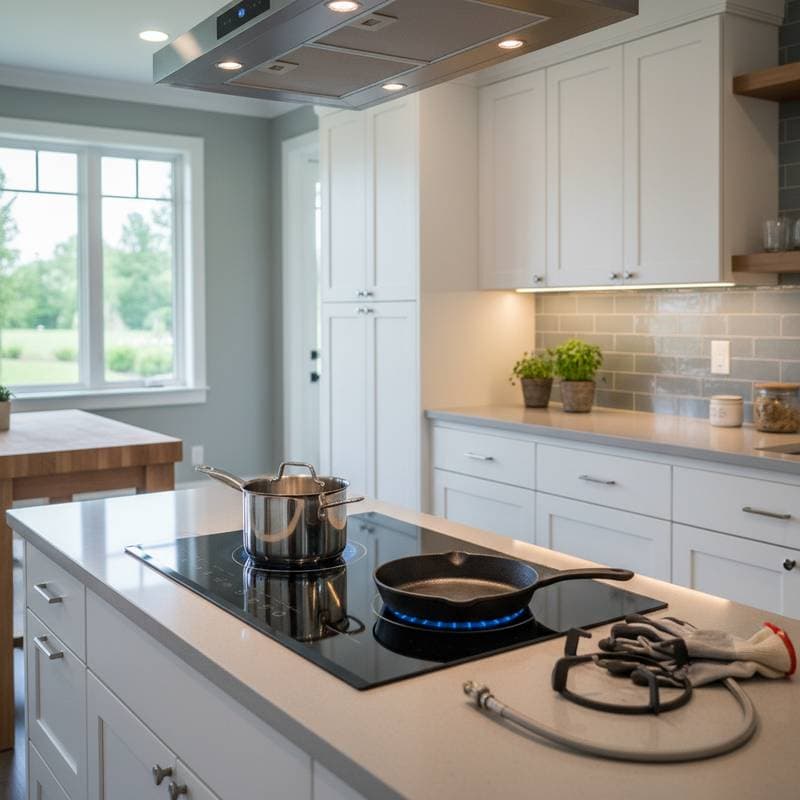Induction Retrofits: Navigating Gas Bans with Precision
Gas bans in urban areas and communities are redefining kitchen operations. This move from open flames to electromagnetic heating surpasses mere regulatory demands. It presents a chance to enhance design. Induction cooktops, previously a choice for professional kitchens, now anchor retrofits that prioritize sustainability, safety, and refined aesthetics.
The Appeal of Seamless Heating Technology
Induction cooking delivers remarkable efficiency in a subdued manner. Magnetic fields heat pots and pans directly, leaving the cooktop surface cool. This approach contrasts with gas flames or electric coils. Brands such as Miele, Bosch, and Fisher & Paykel offer black glass surfaces that blend seamlessly with countertops. Without grates or protruding controls, cleaning becomes simple, and the design aligns with the clean lines of modern kitchens.
Homeowners familiar with the spectacle of gas flames discover subtlety in induction. Power activates instantly and silently. Sauces maintain a steady simmer, and water reaches a boil rapidly. Designers liken this shift to progressing from analog to digital cooking, where functionality integrates with visual purity.
Steps to Prepare for an Induction Retrofit
Installing an induction cooktop in place of a gas model requires careful planning beyond appliance replacement. It affects electrical systems, ventilation needs, and countertop fits. Start by consulting a licensed electrician to verify circuit capacity, often necessitating a 240-volt line. Older homes might require breaker panel upgrades to accommodate the power draw.
- Measure the existing cutout and compare it to the new cooktop dimensions.
- If adjustments are needed, hire a stone fabricator to modify quartz, granite, or solid surfaces accurately.
- Consider updating nearby countertops during this process for a cohesive look.
A flush installation ensures the cooktop aligns perfectly with the counter, fostering a tranquil visual effect that gas setups seldom provide.
The Design Story of Kitchen Electrification
Electrification responds to environmental policies while advancing design principles. It emphasizes simplicity, hygiene, and smart technology. Transitioning to induction marks a broader evolution toward kitchens that operate quietly, remain cooler, and consume less energy.
Architect Lena Hu of Studio Ratio views induction as a driver of contemporary minimalism. She notes that eliminating the bulky range hood required for gas exhaust opens possibilities for innovative elements. Floating shelves, artistic lighting, and uninterrupted backsplashes reemerge. The kitchen transforms from a basic work area into a harmonious living space.
Integrating Materials for Visual Flow
An induction retrofit invites a review of surrounding aesthetics. The glossy glass cooktop, reminiscent of polished stone, calls for complementary materials. Pair it with light oak cabinets, smooth marble counters, or subdued porcelain tiles to offset its shine. Select wall paints in neutral tones like Benjamin Moore Classic Gray or Farrow & Ball Ammonite to enhance the cooktop's understated elegance without clashing.
Update hardware to match this palette. Opt for brushed nickel or dark bronze pulls that reflect the cooktop's depth. Sleek, integrated handles preserve the minimalist vibe. Strategic lighting, such as under-cabinet LED strips or soft pendant fixtures, highlights the countertop's even surface.
Key Performance and Everyday Benefits
Induction excels in responsiveness. Temperature changes occur immediately, reducing mishaps and enhancing control. Without open flames, it avoids emitting indoor pollutants, keeping the kitchen comfortable during long sessions. Families appreciate the safety of a surface that stays cool, minimizing burn risks for children.
Efficiency stands out as well. Direct heat transfer to cookware minimizes waste, shortening cook times and lowering energy bills. This setup streamlines daily routines and supports sustainable living. Homeowners often report smoother meal preparation aligned with personal and planetary health goals.
Adapting to the Shift from Flame to Electromagnetic Heat
Releasing the tradition of visible flames may evoke nostalgia. Gas has represented cooking heritage for generations. Induction counters this with a sense of composed expertise. Silent operation replaces flickering sounds, effortless cleaning restores the surface quickly, and precise controls build confidence in every dish.
Designers recommend hands-on trials before committing. Visit showrooms to operate a demo unit and sense the differences. Most users adapt swiftly and prefer the clarity induction brings. The kitchen emerges as a domain of assured innovation, where tools empower rather than overshadow culinary expression.
Realizing the Full Potential of Your Induction Kitchen
An induction retrofit extends beyond meeting codes. It invests in enduring cooking and design excellence. Cleaner air, lighter visuals, and refined operations define the space.
This upgrade yields a kitchen that balances timeless appeal with progressive features. Meals unfold on a platform of exacting calm, proving induction as an enhancement, not a concession.









